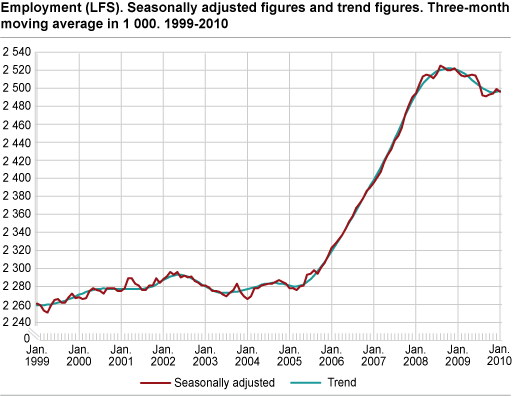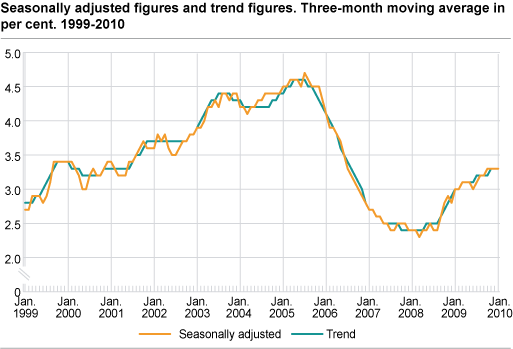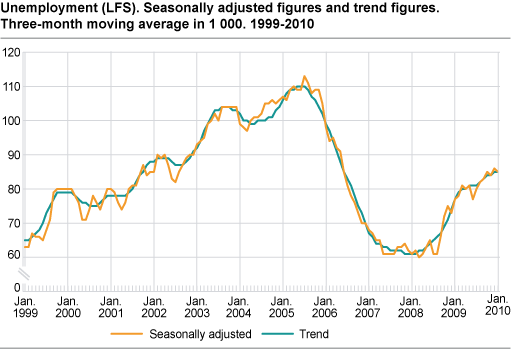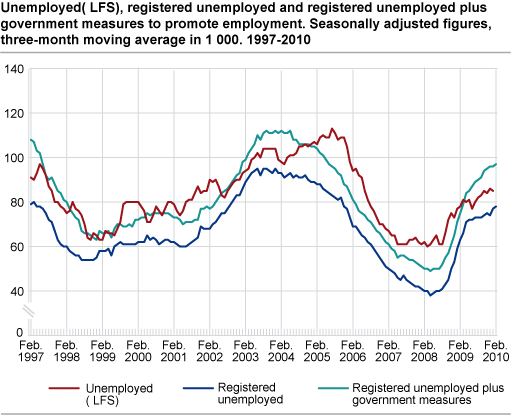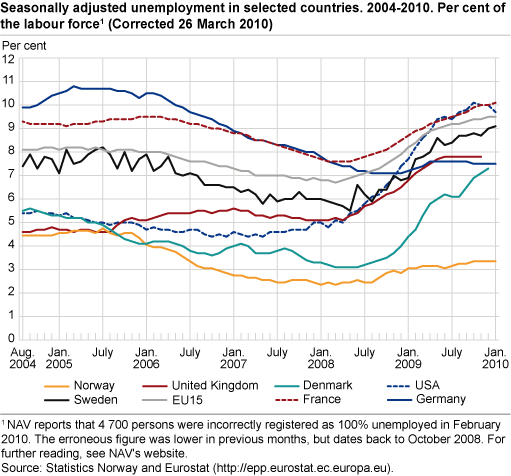Content
Published:
This is an archived release.
Stable labour market
Both employment and unemployment kept stable from October 2009 to January 2010. The unemployment rate was 3.3 per cent of the labour force in January.
Adjusted for seasonal variations the Labour Force Survey (LFS) shows that the unemployment rate remained unchanged from October (as measured by the average of the months from September to November) to January (as measured by the average of the months from December to February). The unemployment rate of 3.3 per cent constitutes 85 000 unemployed persons.
In comparison, seasonally-adjusted figures for those registered unemployed with the Labour and Welfare Organisation (NAV), and persons on government initiatives to promote employment, rose by about 2 000 from October to January. These figures have also been adjusted for seasonal variations.
|
NAV reports that 4 700 persons were incorrectly registered unemployed in February 2010. The erroneous figure was lower in previous months, but dates back to October 2008.This has no consequence for the LFS-numbers published by Statistics Norway, only for the comparisons with NAV's figures. Read more on NAV's website, or contact stein.langeland@nav.no |
Stable employment
There were only small changes in employment from October 2009 to January 2010. Employment increased by 3 000 persons, this is within the error margin of the LFS.
Decrease in the US
The unemployment rate in USA was 9.7 per cent in January; this is down 0.4 percentage points from October. This is the first time since May 2007 there is a decrease in the unemployment rate in USA. The labour market in Europe still shows an increase in the unemployment rate. In the EU-15 countries, the unemployment rate rose by 0.1 percentage points, ending at 9.1 per cent. In Sweden unemployment rose by 0.3 percentage points, ending at 9.1 per cent of the labour force in January. All figures refer to seasonally-adjusted data from Eurostat .
|
The labour force is the sum of employed and unemployed between 16-74 years of age. From October to January the employment rose by 3 000, while the unemployment level remained the same as in October. This gives an increase in the labour force of 3 000. The coherence between the conceptsUnemployed + Employed = Labour force Labour force + Outside the labour force = Population |
Employment and unemployment figures include permanent residentsThe LFS only includes persons who are registered as residents in the population register. Persons working in Norway who are not registered as permanent residents or who are planning to stay for less than six months are not included in the employment figure in the LFS. If these people lose their job it does not count as a fall in employment or a rise in unemployment. In national accounts figures (NR), employed non-residents are included in the employment figure as long as they work in an establishment in Norway. If employment decreases in this group it will count as a fall in employment in NR. Statistics Norway publishes separate figures for all registered non-residents once a year. See short-term immigrants . |
Uncertain figuresThe purpose of making seasonal adjustments is to describe the development over the last year, corrected for seasonal variations. In order to reduce uncertainty, the published series are three-month moving averages of the seasonally-adjusted figures. However, uncertainty means that sampling errors must be considered when interpreting the figures from the LFS. We normally compare the latest non-overlapping three-month periods. An overview of sampling errors in the LFS can be found in “ About the statistics ”, chapter 5 section 3. |
|
Quarterly LFS figures, not seasonally adjusted, are presented in a separate article . |
RevisionsThe complete time series is re-estimated each month, and this may cause some adjustments of previously published figures. See Revisions for more information . |
Tables:
The statistics is published with Labour force survey.
Contact
-
Arbeidsmarked og lønn
E-mail: arbeidsmarked@ssb.no
-
Erik Herstad Horgen
E-mail: erik.horgen@ssb.no
tel.: (+47) 93 08 68 62

